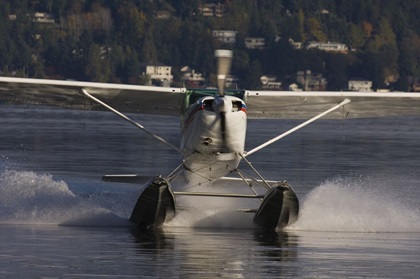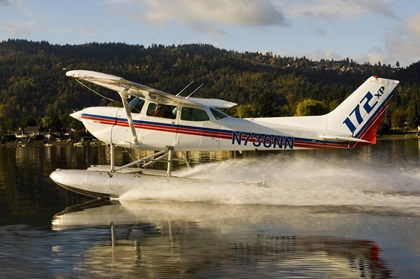Seaplanes conjure images of remote lakes, mountains, and complete freedom. They represent the essence of the unclaimed frontier. And for pilots lucky enough to fly one, they're just great fun! But they demand more concentration than wheeled airplanes. For example, they have no brakes; the moment the engine starts, you MUST maintain positive control of the airplane as is starts to move on the water. What the airplane is doing at any moment requires greater attention from you, especially on takeoffs and landings.
People often ask, “Is landing a seaplane easier or harder than landing a 'regular' airplane?” My answer tends to be consistent: “Yes.” In some ways, it's easier to land a wheeled airplane on a paved runway than a seaplane on the water, and in other ways the converse is true. But one thing is certain: seaplanes are less forgiving than wheeled airplanes when it comes to imprecise pitch control during the takeoff and landing sequences.
First of all, what does it take to add a seaplane rating to your existing pilot certificate? It's all about the water work. You'll typically spend 6-10 hours practicing taxiing, takeoffs, and landings in various wind and water conditions, including some of the more exciting maneuvers like confined-area takeoffs and step turns. Once airborne, it flies just like a wheeled airplane. But on the water, it's a vastly different beast.

Which brings us to the takeoff. During your training, very often you'll hear, “Get that stick back.” Your instructor will drill this into you for a reason: it's vitally important you ALWAYS keep the tips of the floats up from the moment you start the engine. It only takes one moment of broken concentration while water taxiing to relax the back pressure on the yoke and hear the prop cutting through a wave, quickly to realize your positive stick control discipline failed you.
Now for the takeoff roll. When you apply full power, the initial thrust will lift the front of the airplane up and push the rear of the floats down. You'll notice this as a nose-high pitch attitude, and it's called “plowing.” Keep that stick back. As you gain speed, the front of the airplane will lift a second time, and this is where the airplane is literally pulling itself out of the water. This is when you'll finally relax some back pressure and “get on the step.”
While on the step, you're using the center of the floats to plane on top of the water. Pitch attitude matters here probably more than any other time. Just a little nose high and you'll spend more time dragging the back of the floats through the water. Just a little nose low and you are flirting with dipping the tips of the floats in the water at a high speed. If this sounds dangerous, fear not; you'll spend a lot of time in your training getting a feel for exactly where this “step” is.
Now about that landing. Your landing pitch attitude is the same as when you rotated. You want to land on the same part of the float...the step. A little nose high and you'll drop it in like a wheeled airplane in too high a flare. Unlike a wheeled airplane, the floats have no spring or suspension to help soften the landing. There is nothing but the frame of the seaplane to absorb the impact. And too many hard landings like that is an invitation for a hefty annual inspection bill.

Too low of a pitch attitude at touchdown can cause a very discomforting sensation of slowing down too fast. And for good reason because that is exactly what is happening. Water creates significantly more drag on the floats than the pavement does on the wheels of a land plane. So the transition from flying to, well, not flying is more pronounced in a floatplane. The more you can minimize the initial drag on the floats by precisely controlling your pitch attitude, the smoother your landing will be.
Adding a seaplane rating to your existing certificate is an extremely fun rating that can be completed in lieu of a flight review. But more importantly, learning to fly floats will make you a better stick-and-rudder pilot. If you've found yourself moving away from the precise pilot you were when you first learned to fly, getting a seaplane rating will re-teach you the appreciation for energy management and exact pitch control.